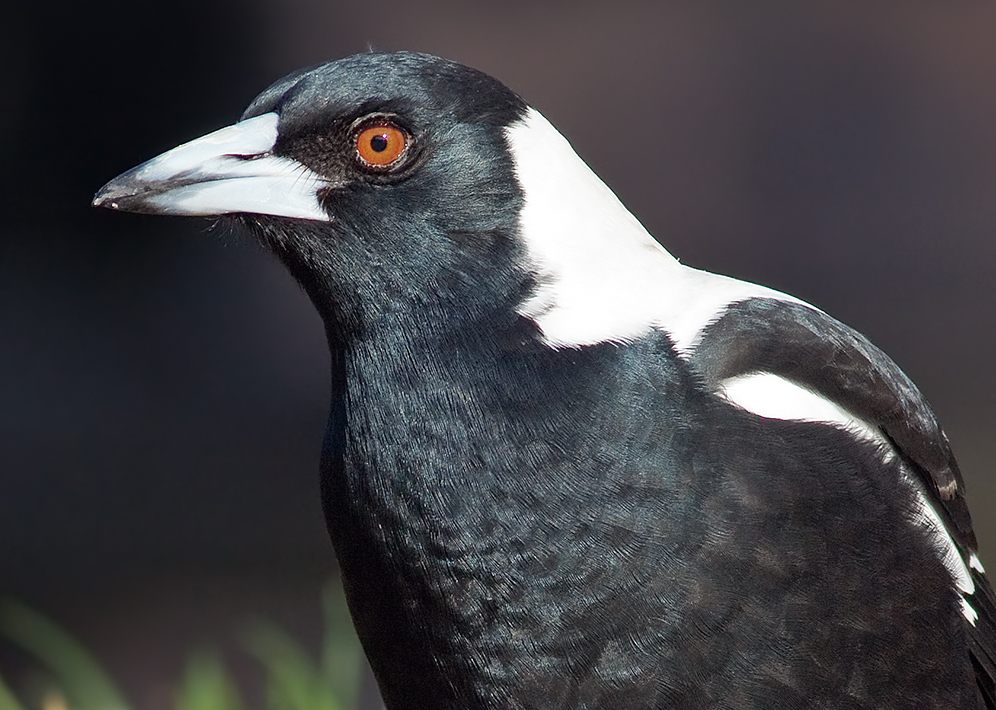You’re Not a True Australian Until You’ve Been Dive-Bombed By a Magpie

The Australian magpie can feel your fear. (Photo: JJ Harrison/Flickr)
Each year, November brings relief to cyclists across Australia. It signals that they will soon be able to ride outside without constantly looking over their shoulders. It means that the reign of terror inflicted by the nation’s dive-bombing magpies is almost at an end.
Around August, headlines such as “How to Avoid Being Swooped This Spring” begin to appear in Australian newspapers. “Swooping” is a behavior in which an agitated, territorial bird will defend its nest by repeatedly menacing pedestrians, cyclists, or “posties”–that’s Australian for mail carrier–who happen to be passing by the relevant tree.
Here’s an example of relatively mild swoop being perpetrated on a postie:
Australian magpies (Cracticus tibicen), a protected species found in all states and territories of the country, are the birds most commonly associated with swooping. During breeding season, which generally runs from August to November, some males of the species become violent defenders of their young, and will attack if you come within a few hundred feet of their nest.
There is a swooping severity spectrum–a bird may fly close to your head, snap its beak, flap its wings, then get bored of you and fly off. Or it could omit the flirtation and just go straight to pecking at your face and eyes, causing serious injury.

A magpie warning sign in Brisbane. (Photo: Alan Levine/Flickr)
Peak swooping season this year has been “a mad couple of months,” says Jon Clarke, who runs the swoop-tracking website MagpieAlert.com. Clarke built the site so that ”anyone across Australia can come and register their swoops to pre-warn others.” It is equipped with interactive maps, magpie-deterrence tips, and user-submitted tales of being targeted by the merciless birds. This season, he has logged around 5,300 swoops.
“We’ve had a number of attacks this year around the eyes and the face and the ears,” says Clarke. “Ears seem to be a pretty common attack point.” Also common, going by the frustration-laden reports written by many MagpieAlert.com users, is the phenomenon of being individually and repeatedly targeted for victimization by a particular magpie. This is not as wild or anthropomorphic a notion as it may seem. Multiple studies over the last five years have shown that magpies are capable of “facial recognition,” and use it to zero in on their swoop victims.
Armed with the knowledge that magpies are indeed out to get them, and that it really is personal, Australia’s walkers, cyclists, and posties are employing a variety of methods to stop those bloody magpies from pecking at their heads. Among pedestrians, Clarke says some residents of rural areas have taken to carrying tree branches when they go for walks outside. They wave them in the air at the first sign of an approaching magpie. For cyclists, it’s about the helmet. Some riders stick googly eyes on them to give the birds the impression they are being watched, while others thread cable ties through the helmet vents to create a spiky surface inhospitable to the magpies.

The beginnings of an anti-magpie hedgehog helmet. (Photo: Bidgee/Wikipedia)
These cunning tactics, however, may all be for naught. As the Brisbane Times reported in September: “Mr. Wilson [Bicycle Queensland chief executive Ben Wilson] said traditional cyclist methods such as attaching zip ties and googly eyes to your helmet are, based on research, ‘essentially useless, and make you look like a dork.’”
While reports of babies being pecked in the eye at the playground make headlines, ocular injuries are relatively rare. ”Most of the damage is actually people falling off bicycles,” says Clarke. He cites a MagpieAlert.com report from last year, of a man who crashed his bike and fractured multiple vertebrae. “He was cycling along and shaking his fist at the bird,” says Clarke. “Obviously the bird got the last laugh.”















Follow us on Twitter to get the latest on the world's hidden wonders.
Like us on Facebook to get the latest on the world's hidden wonders.
Follow us on Twitter Like us on Facebook